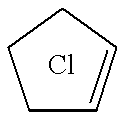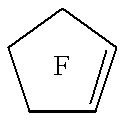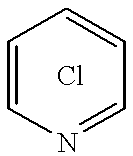Solvents for use in fluorination reactions
a technology of fluorination reaction and solvent, which is applied in the field of fluorination reaction solvents, can solve the problems of inability to meet the requirements of the application of conventional solvents, etc., and achieve the effect of reducing the content of solven
- Summary
- Abstract
- Description
- Claims
- Application Information
AI Technical Summary
Benefits of technology
Problems solved by technology
Method used
Image
Examples
example 2
Octafluorocyclopentene 6.--Octachlorocyclopentene (3.4 g, 10 mmol), potassium fluoride (5.8 g, 100 mmol), PFC 1 (6.5 cm.sup.3) and THTD (2 cm.sup.3), heated for 15 h gave octafluorocyclopentene 6 (1.9 g, 89%); bp 26-28.degree. C. (lit.,.sup.15 25.4-26.5.degree. C.); .upsilon..sub.max / cm.sup.-1 1769 and 1396 (C.dbd.C) and 986-1219 (CF); .delta..sub.F (376 MHz) -117.3 (2F, m, 3 and 5-F), -129.4 (1F, m, 4-F), -148.7 (1F, m, 1 and 2-F); .delta..sub.C (100 MHz) 109.1 (tpt, .sup.1 J.sub.C-F 278.0, .sup.2 J.sub.C-F 23.9, .sup.3 J.sub.C-F 4.9, 4-C), 110.3 (tqm, .sup.1 J.sub.C-F 260.1, .sup.2 J.sub.C-F 23.7, 3 and 5-C), 138.6 (dm, .sup.1 J.sub.C-F 297.9, 1 and 2-C); m / z (EI.sup.+) 212 (M.sup.+, 13.4%).
example 3
1,3,5-Trichloro-2,4,6-trifluorobenzene.--Hexachlorobenzene (1.0 g, 3.5 mmol), potassium fluoride (1.8 g, 31.6 mmol), PFC 1 (10 cm.sup.3) and THTD (4.5 cm.sup.3), heated for 200 h gave 1,3,5-trichloro-2,4,6-trifluorobenzene (0.7 g, 83%); mp 59-61.degree. C. (lit.,.sup.8 57-61.degree. C.); (Found: C, 30.3. C.sub.6 Cl.sub.3 F.sub.3 requires C, 30.6%); .upsilon..sub.max / cm.sup.-1 1603 (C.dbd.C) and 1445 (CF); .delta..sub.F (376 MHz, d.sub.6 -acetone) -114.8 (m); .delta..sub.C (100 MHz, d.sub.6 -acetone) 108.7 (td, .sup.2 J.sub.C-F 22.3, .sup.4 J.sub.C-F 4.9, 1-C), 154.7 (dt, .sup.1 J.sub.C-F 249.8, .sup.3 J.sub.C-F 4.5, 2-C); m / z (EI.sup.+) 234 (M.sup.+, 100%), 236 (M.sup.+, 98.7%), 238 (M.sup.+, 28.5%).
example 4
3,5-Dichlorotrifluoropyridine.--Pentachloropyridine (2.5 g, 10 mmol), potassium fluoride (4.0 g, 70 mmol), PFC 1 (6.5 cm.sup.3) and THTD (2 cm.sup.3), heated for 15 h gave 3,5-dichlorotrifluoropyridine (1.1 g, 60%); bp 157-159 .degree. C. (lit.,.sup.16 159-160.degree. C.) (Found: C, 29.6; N, 6.9. C.sub.5 Cl.sub.2 F.sub.3 N requires C, 29.7; N, 6.9%); .upsilon..sub.max / cm.sup.-1 1358-1434 (CF) and 1569-1604 (CN); .delta..sub.F (376 MHz) -70.0 (2F, d, .sup.4 J.sub.F-F 13.9, 2 and 6-F), -93.8 (1F, t, .sup.4 J.sub.F-F 14.3, 4-F); .delta..sub.C (100 MHz) 104.4 (m, 3 and 5-C), 155.8 (ddd, .sup.1 J.sub.C-F 246.0, .sup.4 J.sub.C-F 17.2, .sup.4 J.sub.C-F 10.8, 2 and 6-C), 164.8 (dt, .sup.1 J.sub.C-F 265.5, .sup.4 J.sub.C-F 5.3, 4-C); m / z (EI.sup.+) 201 (M.sup.+, 100%), 203 (M.sup.+, 55.2%), 205 (M.sup.+, 7.8%).
PUM
| Property | Measurement | Unit |
|---|---|---|
| boiling point | aaaaa | aaaaa |
| molar ratio | aaaaa | aaaaa |
| molar ratio | aaaaa | aaaaa |
Abstract
Description
Claims
Application Information
 Login to View More
Login to View More - R&D
- Intellectual Property
- Life Sciences
- Materials
- Tech Scout
- Unparalleled Data Quality
- Higher Quality Content
- 60% Fewer Hallucinations
Browse by: Latest US Patents, China's latest patents, Technical Efficacy Thesaurus, Application Domain, Technology Topic, Popular Technical Reports.
© 2025 PatSnap. All rights reserved.Legal|Privacy policy|Modern Slavery Act Transparency Statement|Sitemap|About US| Contact US: help@patsnap.com



